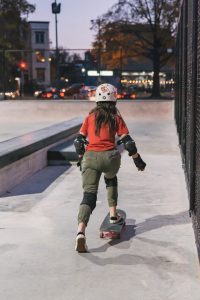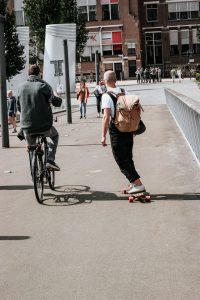We’ve all felt the adrenaline rush of cruising city streets and traffic when skateboarding, weaving safely in between cars and pedestrians. Yet, we must also understand the risks involved here, and prioritize skateboarding safety and your protection. In this current situation, knowing traffic and safety is important.
We’ll cover understanding traffic rules essential for a skater, such as skateboard safety gear or essential protective equipment, speed limits, designated lanes, and cautionary signs. We recommend essential protective gear that can make you stay safe from skateboarding injuries, teach techniques for navigating gridlock with finesse, help find safe places to skate within cities, and remind us to respect other road users too.

Accidents in riding a skateboard are rampant. In skateboarding, we must know safety rules and traffic laws. As we safely advance our skills, remember our shared responsibility to make the roads safe while skateboarding for everyone. So grab your board and wear a multi sport helmet – let’s roll into this exciting journey of hustle and stay safe all the time.
Key Takeaways
We’ll delve deeply into skateboarding safety that can make you stay safe, covering everything from street rules to the essential safety gear or protective equipment required for navigating safely in traffic. We now recognize the safe spots for skateboarding and how to respect others sharing the road. Most importantly, we’ll learn the importance of safely advancing our skateboarding skills in traffic.
- Dive into the nuances of navigating streets on a board, discussing everything from regulatory compliance to the crucial protective gear needed for secure travel among vehicles.
- Identify ideal locales for riding and learn the etiquette of sharing pathways with other commuters.
- Emphasize the significance of progressively enhancing your boarding skills in areas with vehicle flow.
- Explore diverse equipment such as skateboards, longboards, inline skates, and electric scooters, each contributing unique maneuvers and techniques to the culture.
- Discuss various boarding styles, including street, park, vert, downhill, and slalom, noting that each demands specific abilities and protective measures in busy areas.
- Stress the importance of wearing multi sport helmet and suitable footwear, aiming for confident and responsible riding on pavements.
- Promote a culture of conscientiousness within the boarding community, ensuring each journey is as secure as exciting.
Skateboards, longboards, inline skates, and electric scooters enrich the skateboarding culture, providing skateboarders with various tricks, jumps, and flips to master. Whether street skating, park skating, vert skating, downhill skating, or slalom, each style of skateboarding demands specific skills and safety measures, especially in traffic.
As we strap on our helmets, lace up our slip-resistant shoes, and hit the pavement confidently, remember that we’re not just skateboarding for fun—we’re practicing skateboarding safety in traffic. Let’s continue to foster a culture of safety in skateboarding, ensuring that every ride in the street is as safe as it is exhilarating. Stay safe while skateboarding fellas!
Understanding Rules
You’ve got to know the traffic rules in and out for your safety and to ride that board in the concrete jungle smoothly. Signals and road markings aren’t suggestions; they’re our guiding lights. Let’s respect them as we weave through this world on four wheels. Understanding these rules helps us serve others by preventing accidents in our way.
- Familiarize yourself with gridlock rules thoroughly for safety and smooth riding in urban environments.
- Treat signals and road markings as essential guidelines, not mere suggestions.
- Respect and follow these guidelines to navigate four wheels and help prevent accidents.
- FamilyHype emphasizes the importance of understanding road rules and sharing this knowledge for collective safety.
- Always wear appropriate safety gear or protective equipment while riding, including:
- Helmets (consider multi sport helmet that meets the safety standards set by Consumer Product Safety Commission standards)
- Elbow pads
- Wrist guards
- Knee pads
This activity demands focus, skill, and a deep understanding of local gridlock regulations to ensure secure and responsible riding.
The skateboard community at FamilyHype suggests that, like with motor vehicles, we all take the time to understand the rules of the road and share our knowledge with others for the greater good. We should also ensure we wear the appropriate safety gear or protective equipment while boarding, including helmets, elbow pads, wrist guards, and knee pads.
This activity requires focus, skill, and an understanding of the rules of the road. Understanding the traffic rules and regulations of the state and local areas is important to be safe while skateboarding and having fun.

Traffic rules for skateboarding include traffic signs, lane markings, crosswalks, sidewalks, and speed limits. It’s important to understand and obey these rules of the road to avoid accidents and ensure skateboarding safety. Skateboarding with knowledge of traffic rules ensures the security of everyone on the street.
Gear And Protective Gear
Skateboarding can be enjoyed by an individual and in your area, but it becomes even more fun when more than one person is involved. You can laugh, cheer, and share exhilarating moments while riding together. However, before tackling the concrete jungle on your board, it’s critical to gear up with essential safety equipment to stay safe. Safety skateboarding never put skateboarders on the skateboard without proper safety gear. Every piece, from helmets to knee pads, is key to ensuring skateboarding safety.
As mentioned earlier, we should also be aware of the different safety gear or protective equipment available, such as wrist guards, elbow pads, and shin guards (read the safety standards in your locale). Knowing and following this basic rule is one must of a responsible skateboarder. The American Academy of Orthopaedic Surgeons recommends using the right protective gear in skateboarding.
- Helmets: Protects the head from impacts and falls, which is essential for preventing serious head skateboarding injuries.
- Knee Pads: Cushions the knees during falls, which are crucial for protecting knee joints and soft tissues.
- Wrist Guards: Supports and shields the wrists, reducing the risk of fractures and sprains.
- Elbow Pads: Guards the elbows against scrapes and impacts, which is important for elbow joint protection.
- Shin Guards: Offers protection to the shins from hits and bumps and helps prevent bruises and fractures.
As part of their marketing campaign, many brands boost the features of their safety gear. Do research and read reviews to ensure the quality and comfortability of your gear.
We understand the importance of family and protection. That’s why we want to ensure you have the right knowledge and tools before you master the art of maneuvering through bustling city traffic. With the right knowledge and tools, we can confidently hit the streets and enjoy our time riding our skateboards.
The Art Of Riding
Navigating through city streets on your skateboard isn’t just a show of skill but an art form. It requires skateboarding practice, respect for other people driving, and a well-tuned board for a smoother ride. Skateboarding provides entertainment and teaches discipline and responsibility.

When it comes to city streets, safety should be a must. Use skate tricks wisely, not just to show off but to help you avoid obstacles. Always anticipate drivers’ actions since they may not see you. Remember, we’re all sharing the road; having mutual respect and understanding goes a long way.
Next, let’s explore the safe havens where you can let loose your skateboarding skills. There are skate parks, empty parking lots, school yards, and playgrounds, to name a few. Skate parks offer a variety of obstacles, from ledges to handrails and bowls, which can help you hone your skills and get comfortable.
Identifying Secure Places To Avoid Accidents
Finding the perfect spot to shred isn’t just about seeking smooth pavement or thrilling obstacles. It’s about discovering a haven where your wheels can roam freely, and you can push your skills to the brink without jeopardizing anyone’s wellbeing. Skateparks provide a safe environment for skateboarders where riders can practice their skills and techniques without the fear of interference from traffic or pedestrians. Moreover, the skatepark offers an area where skateboarders can interact with each other, share experiences, and stay up-to-date on the latest trends.
- Seek designated zones that combine smooth pathways and challenging terrains without risking public well-being.
- Opt for environments such as skateparks, which are free from vehicles and pedestrian interruptions and allow for focused skill enhancement.
- Take advantage of diverse facilities like ramps and rails provided in these parks to push your abilities further in a controlled space.
- Embrace the community aspect of these parks, where enthusiasts can exchange insights and experiences and stay informed about the latest trends in the sport.
- Look into other areas like empty parking lots and schoolyards for refining basic maneuvers.
- Use playground structures to practice technical moves, especially on available ramps and rails ideal for precision techniques.
- Utilize urban structures for creative expression in movement while maintaining an awareness of and respect for communal spaces and their users.
- Avoid skateboarding in private areas without proper permission.
To that end, we have compiled a list of skatepark benefits, including safety, accessibility, variety, and community. Safety is vital, as skateparks provide a place to practice without worrying about security hazards. Accessibility is also key, as skateparks are usually located in public areas and can easily be reached by people of all ages and abilities. Variety is another great advantage of skateparks, as they often feature ramps, rails, and other obstacles to challenge the skateboarder. Finally, skateparks offer a community of people who share the same passion and respect each other’s skateboarding skills and experiences.
These benefits are invaluable, making skateparks the ideal destination for skaters who want to practice their skills and enjoy the thrill of the sport without risking the safety of others or potential injury.
Empty parking lots and schoolyards are also great places to find and practice the basics. Playgrounds often have ramps and rails that can be used to practice grind tricks or slides. On the side, many skaters also utilize street fixtures for improvisational moves. You can confidently maneuver through the urban terrain with the right skill and attitude.
Respect Others
Safely riding a skateboard in traffic is a crucial aspect to consider, especially when navigating busy streets. It’s essential to wear protective gear and reflective clothing to ensure visibility and safety. Skateboarding should be avoided in areas not designated for this form of transportation. Stay alert at all times to the surroundings. When using a roadway, always skateboard on the right side to comply with norms and respect others on the road and in skate parks. Do not hitch a ride from a person, car, or other forms of vehicle while riding your skateboard.
As we navigate the urban jungle as a person on a skateboard it’s crucial to remember that we’re not the only ones out there. Sharing space with pedestrians and cyclists requires us to know our surroundings and respect their right to use those spaces. Ensuring our boards are slip-resistant and in good working condition can prevent unexpected accidents.
Moreover, being considerate of vehicles is equally important. After all, they’re bigger than us and can cause serious harm, including a potential head injury, if we fail to give them due regard.
Sharing Space With Others For Security
Sharing the road with pedestrians and cyclists can be challenging for skateboarding users. We must practice respect and mindful navigation to ensure everyone’s safety. As part of the broader community on the move, skateboarders must also be considerate of the vehicles around them. This is a key part of skateboard etiquette.

It is important to remember that skateboards are part of a larger community in shared spaces and that mutual respect and safety are paramount.
Riding Accidents And Being Considerate Of Vehicles
If you’re skateboarding, being aware of the other vehicles sharing the space with you is important. Always being considerate of vehicles and practicing proper skateboard etiquette must be emphasized. It’s equally critical not to lose control due to a slippery top surface, so choosing resistant shoes is vital for safety.
Regarding skateboards, including the innovative metal boards, it’s vital to always yield to vehicles, stay visible, and signal your intentions.
One of the basics is being aware of the skateboard industry, which includes a variety of skateboard types, styles, brands, and tricks. It’s also important to be familiar with skateboard safety, like wearing a skateboard helmet and protective gear. Additionally, being aware of skateboard laws and regulations in your area is important.
In this article, you can learn the importance of being considerate of vehicles and providing tips for enhancing your proficiency. We’d love to hear from you if you have any feedback about this article or tips!
Advancing Your Skills
Pushing your limits on a skateboard can be exhilarating, but it’s crucial to remember that there is no glory in taking unnecessary risks. We must practice skill progression responsibly and be mindful of our environment.
Assess your potential risks before attempting a new trick or navigating through traffic. By doing so, we can ensure we are advancing our skills safely and being considerate community members. We must think about our abilities and ensure we don’t attempt tricks beyond our skill level. Together, we can ensure that we advance our skills safely and responsibly.
Skateboard And Protective Gear Maintenance And Care
Gear maintenance should be a top priority, as well as understanding different skateboard types and their unique needs. Constantly check if your skateboard and protective gear are in good working order before using them. Skateboard issues that need urgent fixing are loose, broken, or cracked parts, sharp skateboard edges, and others. Avoid using equipment with nicks and cracks. Fix them urgently or replace them if necessary. If we maintain our skateboards properly, we will be able to enjoy their services for a longer period of time.
Skateboarding Note For Young Children
Skateboarding is very famous for young children and teens. However, the American Academy of Pediatrics does not advise skateboarding activities for young children 5 years old and younger. Young children 6-10 require more adult supervision.
Conclusion
In conclusion, the excitement and thrill of skateboarding through city streets come with significant responsibilities. We must master the art of maneuvering through traffic and prioritize our safety and the safety of others.
FamilyHype emphasizes the importance of understanding traffic rules, wearing protective gear, and respecting all road users. As skateboarders, our actions on the road can have profound impacts. Let’s embrace our roles as cautious and responsible members of the traffic ecosystem, ensuring a safe environment for everyone.
By advancing our skills thoughtfully and safely, we can enjoy the ride in the street while maintaining the spirit of protection and community engagement. Always remember: safety, traffic awareness, and responsible skateboarding are key.
Frequently Asked Questions (FAQs):
DISCLAIMER (IMPORTANT): This information (including all text, images, audio, or other formats on FamilyHype.com) is not intended to be a substitute for informed professional advice, diagnosis, endorsement or treatment. You should not take any action or avoid taking action without consulting a qualified professional. Always seek the advice of your physician or other qualified health provider with any questions about medical conditions. Do not disregard professional medical advice or delay seeking advice or treatment because of something you have read here a FamilyHype.com.
